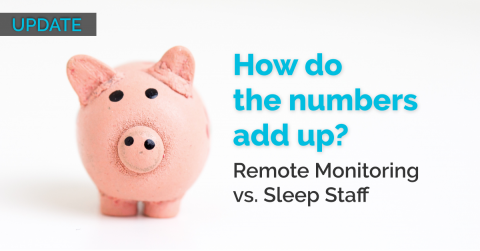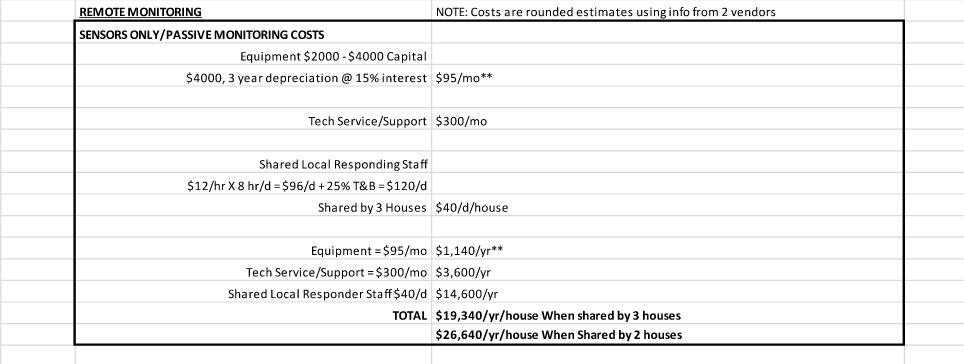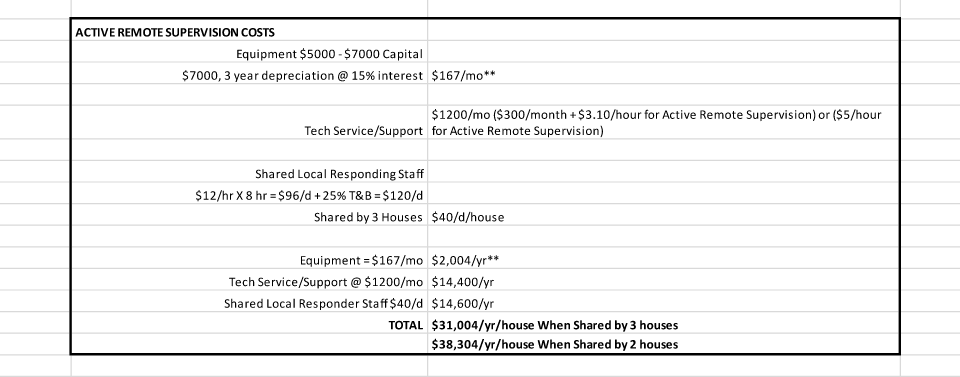
Do the Numbers

Updated DWRS Rate Framework as of Jan. 1, 2022. With the addition of the Competitive Workforce Factor (CWF) wage rates increase across the board for on-site and remote staffing.
Expert Contributor: Sandy Henry, Technology Advocate and former community residential services provider
When deciding to implement a new support strategy it is important to run a cost analysis to fully plan out the business case for your organization. A sample cost analysis has been created below that can be used to help analyze anticipated costs and revenue when going from on-site sleep to alternative overnight supervision. In very round numbers, it may be surprising to know:
- All other things being equal converting 8 hours/day of sleep staff hours to remote monitoring increases revenue about $8,000 (per 4 person site), as calculated on the RMS Framework.
- Savings from replacing on-site sleep staff is usually around $30,000 (plus expenses to recruit, train, and manage those employees).
- Cost of the technology is the most variable but may be less than expected. In our sample the equipment and technology vendor support/service ranges from $5,000 to $16,400 per year per house, depending on whether using passive or active remote supervision.
- Cost of a local staff on duty to respond to needs at the house can be in the $40,000 range, but when shared by 3 or even 2 houses the cost goes to $14,500 – $22,000 per house per year.
In short, even with the new costs for services and technology, the increased revenue plus cost savings create funds that can be used to support other aspects of the home’s costs/services. For a more detailed look, let’s walk through our sample.
Remote Monitoring Rates VS. On-Site Sleep Staff Rates
In our sample, we are comparing revenue from on-site shared sleep staff (V1) to the revenue of overnight shared remote monitoring (V2). Because remote monitoring hours in the DWRS rate framework are calculated at the same hourly rate as on-site awake staff in the RMS Framework (yes, you read that right!), there is generally a revenue increase of around $8,000. Let’s repeat that if it did not completely sink in. The hourly amount calculated for remote supervision hours = hourly awake staff calculated rate, $13.53 for 2018*, compared to the rate for sleep staff of $8.35. (*$14.17 and $10.00 respectively as of 2020)
Still don’t believe it? Download the DWRS worksheet from DHS, fill in your numbers, and see for yourself.
Our Sample Revenue Calculation:
Cost/Savings
As a baseline, we are calculating the cost of paying one household’s sleep staff for one year using $9.50/hr as the base pay and adding in 25% for taxes and benefits (use your true staffing cost for a more accurate analysis). When converting to remote monitoring overnight, these “costs” become savings because they’re an expense no longer incurred. Other related costs could be added to this sample, such as recruiting, training, and managing those staff that are no longer needed, but for this example we’re keeping it simple.
Passive Monitoring Costs
Building on our scenario, below are the costs associated with “passive” remote monitoring (i.e. using motion sensors and other devices but not cameras/video with a live remote caregiver actively monitoring the site). We have obtained quotes from 2 vendors and averaged their estimates. Your costs may vary based on your circumstances, but these numbers are a best effort for a reasonable sample.
The initial capital outlay on equipment will be the largest initial investment, but remember purchased equipment will be depreciable. We used a 3 year depreciation schedule. Equipment rental vs. purchase is available with most remote monitoring agencies. Rental rates are higher than monthly depreciation and interest, as shown here, but often include repairs and replacement. In addition to the equipment purchase, there will be a support fee, generally including access to the software, initial and ongoing programing, training, and 24-hour response/support.
When using remote monitoring, local response staff is still required in case staff intervention is needed. In our scenario, we are assuming one shared staff for three houses. We’ve also included the numbers for shared staff for only 2 houses for comparison.
Active Monitoring Costs
The rationale for the active remote monitoring costs is the exact same. The equipment costs increase because 2-way audio/video is needed for off-site active monitoring as well as an additional hourly monitoring fee. For these numbers, the higher estimate of $5/hour of active remote supervision has been used, and eight hours per night of monitoring is assumed. The cost of shared local response staff remains the same as in passive monitoring above.
Sample Recap
When moving to remote monitoring supervision from sleep staff in an hour for hour exchange – your rates will increase slightly.
- The revenue difference for Remote Monitoring vs. Sleep Staff is $8,336.60/yr
- 8 hrs of on-site sleep staff costs approx. $34,675/yr
- This amount is saved when using remote monitoring
- 8 hrs of Passive Monitoring (sensor only) costs $19,340/yr (including local responder staff shared by 3 houses)
- This usage leads to an annual $23,671.60 in savings
- 8 hrs or Active Remote Supervision costs $31,004/yr (including shared local responder staff for 3 houses)
- This usage leads to an annual $12,007.60 in savings
The main sample is comparing outcomes when sharing responder staff with 3 houses. If we share responder staff with just 2 houses, the savings are as follows:
- Passive Monitoring = $16,371.60 Savings
- Active Monitoring = $4,707.60 Savings
The hourly rate for on-site sleep staff in the RMS Framework is currently (2018) below minimum wage. This leads to certain loss for your organization. By Implementing remote monitoring, organizations not only increase security and accountability (not to mention quality of life improvements for person served), but also based on above scenario, savings may be rolled back into awake staff wages, expanded services, or used to recoup other costs. Implementing remote monitoring will help increase and maintain a talented and dedicated workforce and strengthen service offerings.






